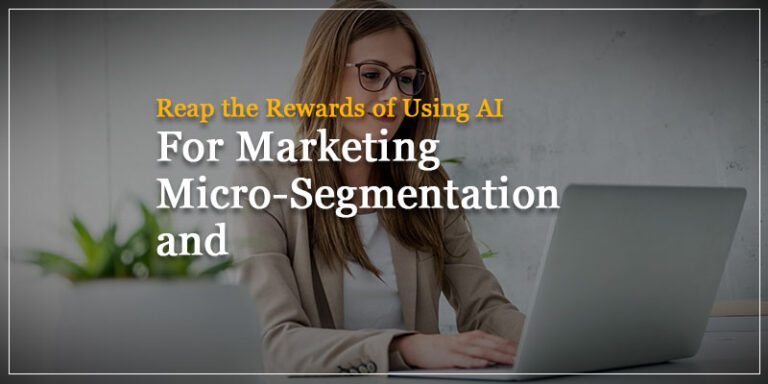Reap the Rewards of Using AI for Marketing Micro-Segmentation and Hyper-Personalization at Scale


As part of Solutions Review’s Contributed Content Series—a collection of contributed articles written by our enterprise tech thought leader community—Isabelle Guis, the North America CEO and Global CMO at Brevo, explains how companies can use AI to improve their marketing micro-segmentation and hyper-personalization efforts.
 Customers today want personalized content; they want it via their preferred channel, and they expect this strategy to evolve depending on where they are, the day of the week, and so forth. According to McKinsey, 71 percent of consumers expect interactions to be personalized, and 76 percent are frustrated when they aren’t. This is as true for B2B customers as it is for B2C: Indeed, B2B customer expectations have evolved as B2C shopping habits are infused into the workplace, making prospective B2B customers more comfortable engaging with brands and purchasing solutions solely online.
Customers today want personalized content; they want it via their preferred channel, and they expect this strategy to evolve depending on where they are, the day of the week, and so forth. According to McKinsey, 71 percent of consumers expect interactions to be personalized, and 76 percent are frustrated when they aren’t. This is as true for B2B customers as it is for B2C: Indeed, B2B customer expectations have evolved as B2C shopping habits are infused into the workplace, making prospective B2B customers more comfortable engaging with brands and purchasing solutions solely online.
Certainly, personalization and localization of content have never been so crucial for success, with companies that do a good job at personalization generating 40 percent more revenue from those activities than others. Still, it’s not humanly possible for most companies to execute the required endless market segments and personas at scale unless they have a large marketing team. For years, marketers have had the ability to develop many market segments but were only able to act on a few of the most promising ones due to the time and labor needed to create the necessary content. Now, with generative AI, marketers can execute highly personalized campaigns at scale, developing content that can be personalized for each micro-segment of prospective customers.
Actionable Micro-Segmentation and Hyper-Personalization: The Next Frontier in Marketing with AI
The marketing landscape has always been fast-moving, and AI has only accelerated its evolution. In 2019, AI implementation in marketing toolkits increased by 27 percent as marketers realized that AI can help companies target the right audiences. Since its introduction to marketing, AI has powered a long list of applications, including chatbots, online product merchandising, social media sentiment analysis, and web analytics.
Now, huge quantities of data and computing power, as well as a new generation of algorithms to power adaptive models, have opened up even more opportunities using AI—specifically, generative AI, which generates output similar to the inputs humans provide to train algorithms, like text or images. It represents a major shift from passive content analysis to active content generation.
How does this benefit marketers? Each customer’s journey is a complex web of decisions and interactions, and each has a different problem to solve and learns about a company and its products at a different pace, in a different way, and through a different channel. Often, and especially in B2B, there are multiple touchpoints, and they evolve over time, making it almost impossible for marketing teams to solve this multi-dimensional problem on an ongoing basis.
Marketers understand that each customer is unique, so while AI helps them scale engagement with as many segments as possible, personalizing content at scale is a massive task. This is where generative AI can help. Writing content like emails, websites, e-books, and blogs for a specific product recommendation in a specific language for many personas and market segments requires a significant amount of time and resources— unrealistic for most companies with a small to moderate-size marketing team. But all this can be achieved with generative AI, so micro-segmentation becomes actionable as content can be hyper-personalized for greater engagement and more successful campaigns. Imagine a world in which each customer receives an individual email with a unique value proposition for the specific product they are interested in for a Black Friday promotion. That’s the future of marketing with generative AI.
Narrowing Down the Choices
Deciding on the right level of AI use for your company can be challenging and overwhelming, as so many options exist. You may decide on a ready-to-use solution, a customizable app with integrations, or to build it in-house entirely. Because it’s the lifeblood of AI, data will have a bearing on which type of solution you choose.
If, for example, you’re a marketer for an e-commerce business with a lot of data, you will likely want to capitalize on a differentiator (i.e., understanding market trends) before the competition, determining customer preferences and aligning your supply to your future demand predictions. In this case, building your own solution in-house would be the best path, as it becomes a strategic asset.
Marketers at a smaller company without much data can still use AI to achieve faster growth and build loyalty by suggesting products or services to specific customers, renewing memberships (if applicable), or updating customer information. For this kind of company, a standalone off-the-shelf AI application that helps you engage with their customers at the best time of the day based on historical activity would work best.
Most companies fall somewhere in-between, where they have a moderate amount of data, some of it critical and highly differentiated from their competitors. Marketers at these businesses might do best with an application that can be customized to interpret this data in order to serve customers differently than competitors (e.g., personalized content creation) and use off-the-shelf AI tools for the rest.
A local fitness studio is a great example of an industry that typically falls in the middle. Using a customizable AI solution, they can analyze their key differentiators, including the classes they offer, their trainers, and gym locations, to identify each member’s attendance habits. Then, with an off-the-shelf AI solution, they can cross-promote similar class types or sessions led by their favorite trainer via the best channel and deliver that message at the time they’re most likely to check their messages.
Regardless of your choice, understand that AI is a long-term commitment. To get the most out of your AI system, you must use it on an ongoing basis rather than a one-off. If you stop feeding your model with “relevant data,” it loses its impact, and you won’t continue to reap the benefits. While AI’s “hype” is well-deserved, it’s important for companies to look past the hype and only adopt it where it makes sense for their marketing organization. But with so many applications and all the demonstrated benefits afforded by AI, it at least deserves an initial look so your company doesn’t miss out on the potential windfalls it can deliver.



















